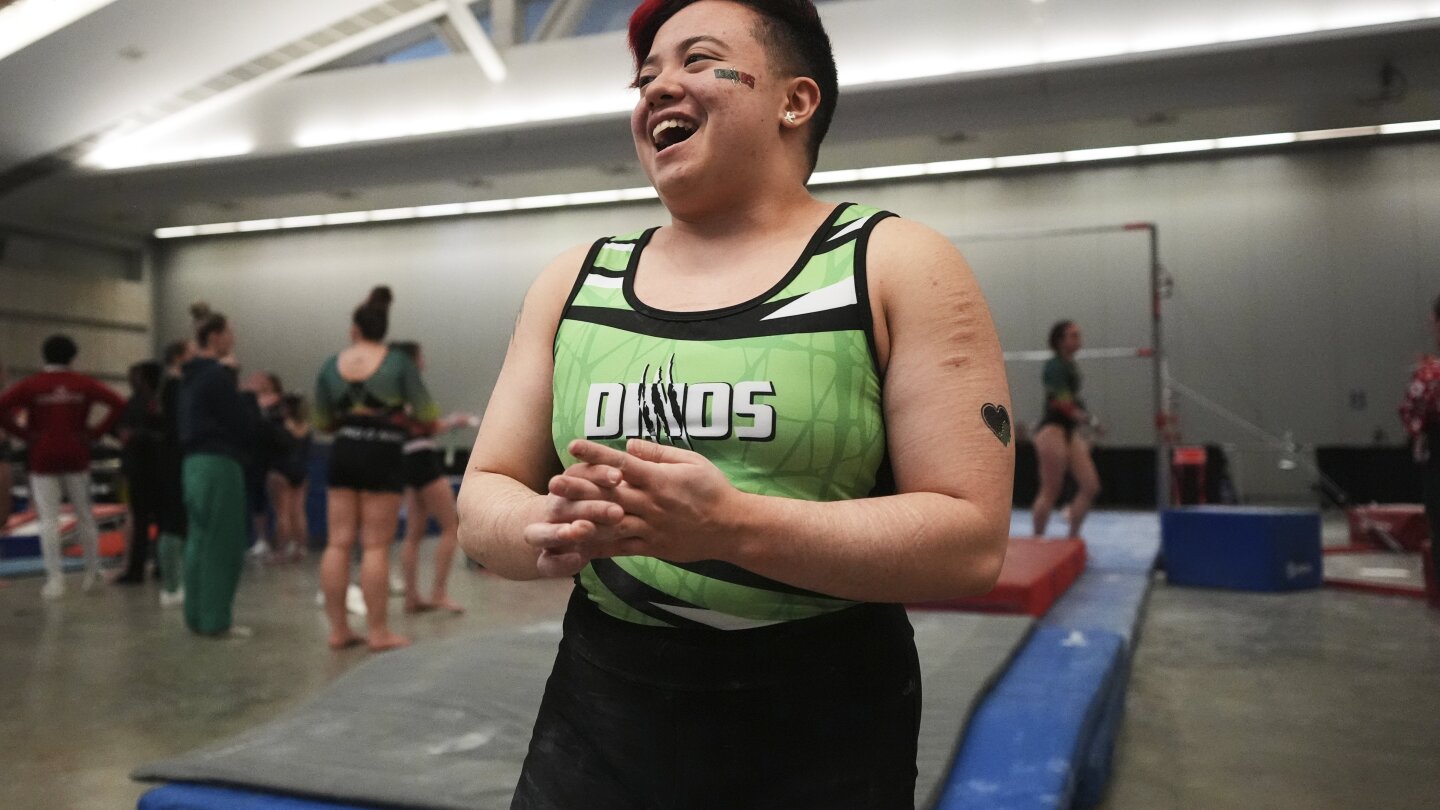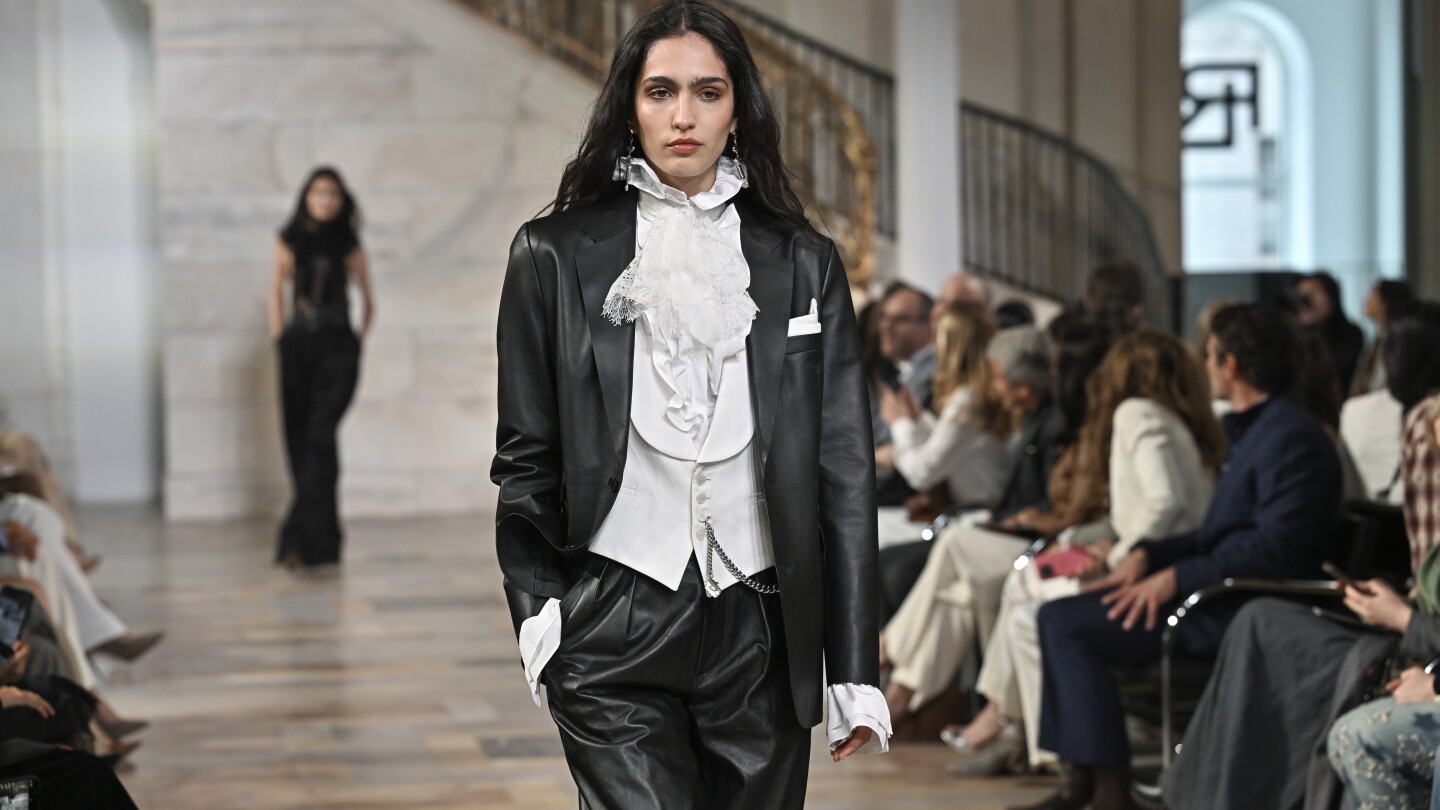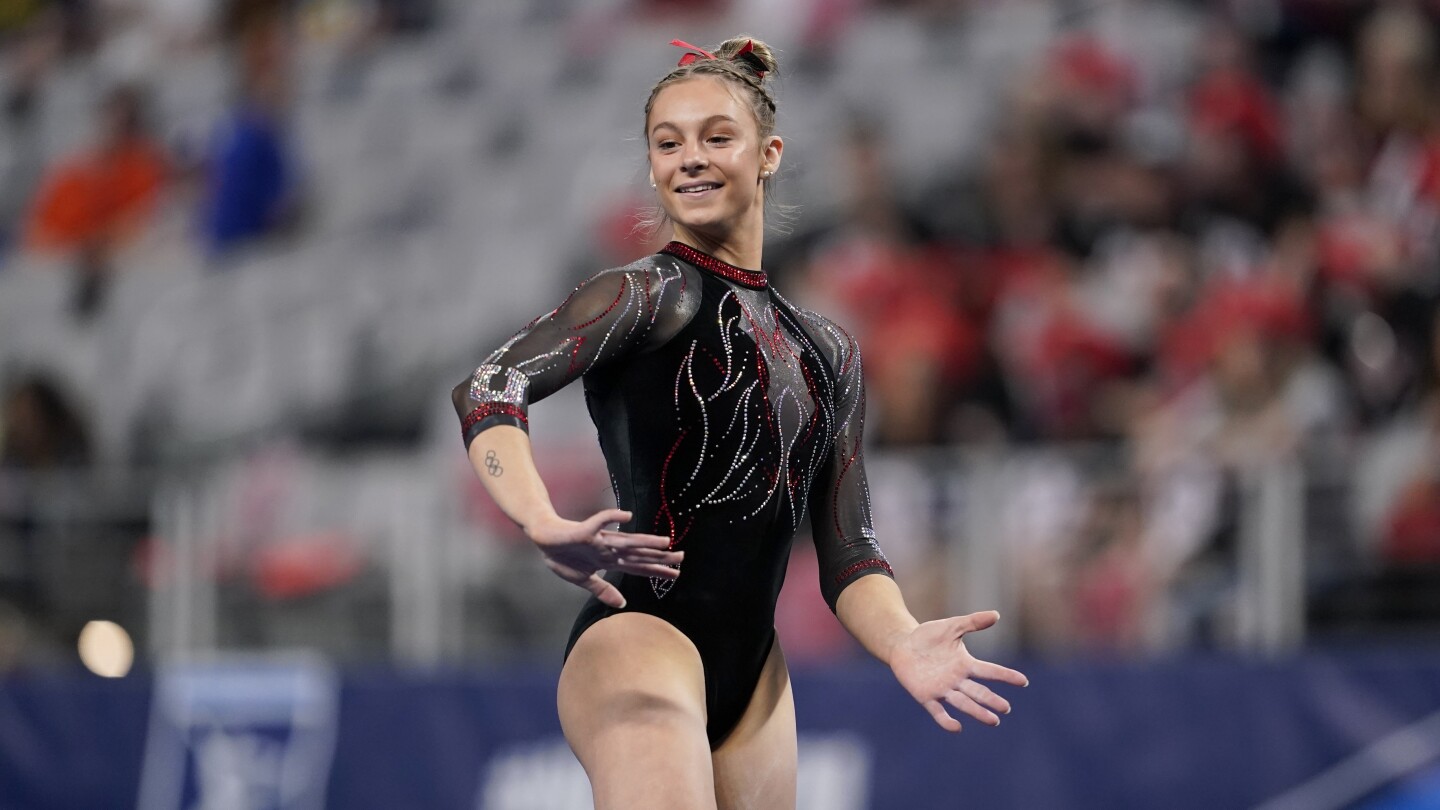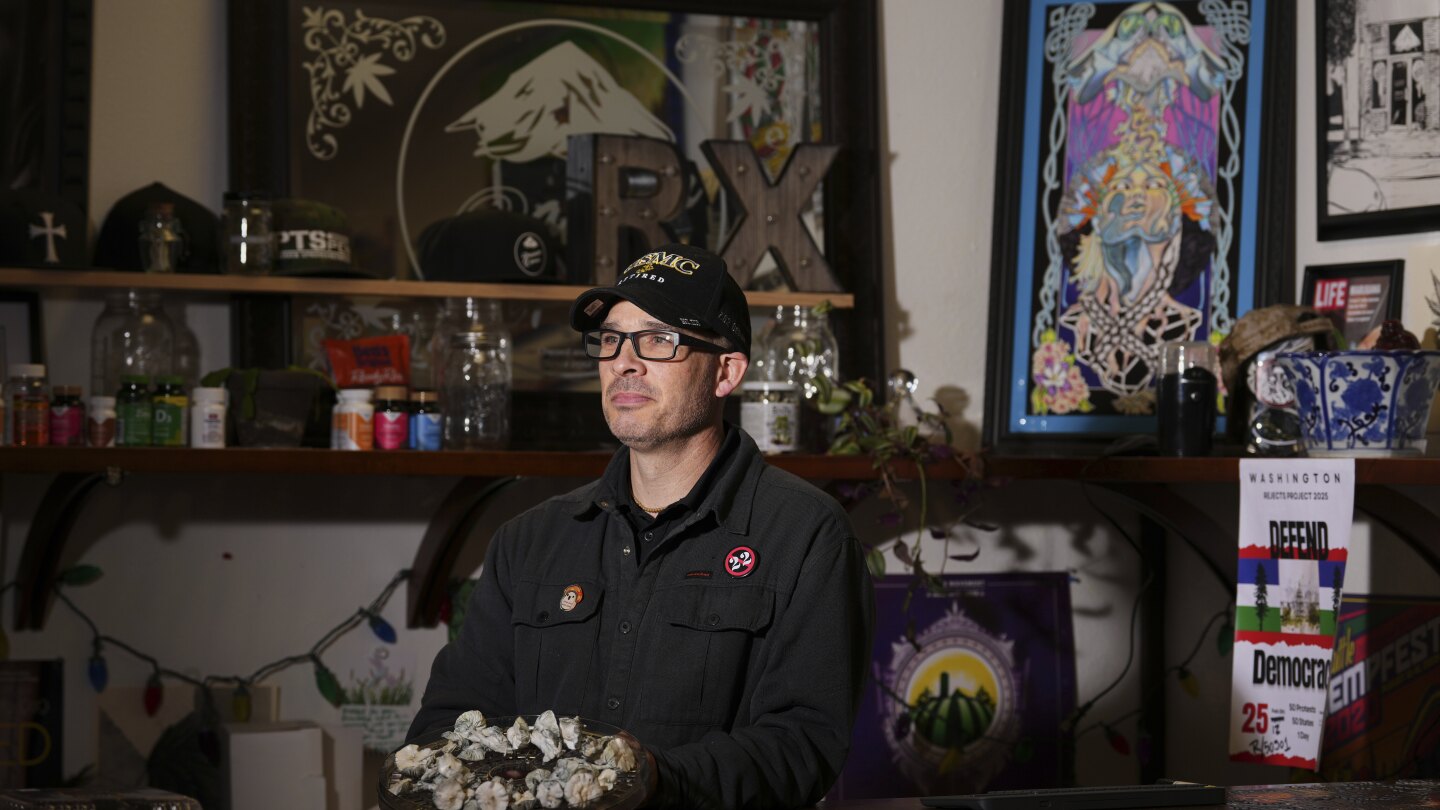Lifestyle
Trans athletes are under more scrutiny than ever. Some have found a safe space in gymnastics

PITTSBURGH (AP) — Raiden Hung can’t imagine a life without gymnastics. And to be honest, he doesn’t want to.
There’s always been something about the sport that’s called to him. Something about flipping. Something about the discipline it requires. Something about the mixture of joy and calm he feels whenever he steps onto a mat.
“It keeps me sane, I guess,” the 21-year-old student at Northeastern University in Boston said. “Gymnastics is the love of my life basically.”
Raiden Hung, of Jurassic Gymnastics in Boston, center left, celebrates with teammate Fay Malay after competing in the floor exercise at the 2025 NAIGC national competition in Pittsburgh, Friday, April 4, 2025. (AP Photo/Gene J. Puskar)
The hours in the gym have long served as a constant for Hung. The one thing he can always depend on. The one place where he can truly feel like himself.
Still, Hung feared he would be forced to give up gymnastics when he realized in his late teens that he was non-binary. He had identified as female most of his life and competed in women’s events growing up. He says he now identifies as trans-masculine.
Part of Hung’s transition included beginning hormone replacement therapy, something he considered putting off over worries that it meant he would no longer be able to compete.
“It was sort of like, ‘Do I have to make a choice?’” Hung said. “And that would have probably been awful for my mental stability, like having to choose between the two.”
Raiden Hung, of Jurassic Gymnastics in Boston, competes on the balance beam at the 2025 NAIGC national competition in Pittsburgh, Friday, April 4, 2025. (AP Photo/Gene J. Puskar)
The National Association of Intercollegiate Gymnastics Clubs gave Hung safe harbor. The stated mission of the steadily growing organization that includes more than 2,500 athletes and 160 clubs across the country is to provide a place for college and adult gymnasts to continue competing while “pushing the boundaries of the sport.”
That includes, but is hardly limited to, being as gender-inclusive as possible.
During local NAIGC meets, for example, there are no gender categories. Athletes compete against every other athlete at their designated skill level, which can run from novice/developmental routines to ones that wouldn’t look out of place at an NCAA Division I meet.
Gymnasts can also hop on whatever apparatus they want. Women on parallel bars. Men on the balance beam. Just about anything goes. At its annual national meet, the NAIGC even offers the “decathlon,” which allows athletes of all gender identities to compete against each other across all 10 disciplines — six in men’s, four in women’s — of artistic gymnastics.
“(We want) people to be able to continue doing gymnastics into adulthood in a way that feels comfortable and safe and supportive for them,” said Ilana Shushanky, NAIGC’s director of operations.
Raiden Hung, of Jurassic Gymnastics in Boston, competes in the floor exercise at the 2025 NAIGC national competition in Pittsburgh, Friday, April 4, 2025. (AP Photo/Gene J. Puskar)
A challenging climate
The approach comes as transgender athletes find themselves the target of increasingly heated rhetoric.
President Donald Trump signed an executive order in February that gave federal agencies wide latitude to ensure entities that receive federal funding abide by Title IX in alignment with the Trump administration’s view, which interprets “sex” as the gender someone was assigned at birth. A day later, the NCAA said it would limit competition in women’s sports to athletes who were assigned female at birth.
The message to the transgender community at large was clear: You do not belong here. Several trans and/or non-binary members of the NAIGC, which is independently run and volunteer-led and does not rely on federal money to operate, felt it.
Calix Hill, a 26-year-old gymnast who identifies as trans-masculine, returned to the sport two years ago following a lengthy break, the fallout of what they described as an abusive environment in the gym where they trained as a child. Hill was going to law school in the South when they began transitioning and said it was not unusual for them to be met with homophobic slurs while walking across campus or being regularly misgendered or singled out by professors.
Multiple trans or non-binary athletes who spoke to The Associated Press said they pondered quitting following last fall’s election, despondent over what at times feels like an increasingly hostile environment toward their community.
None did. One viewed stepping away as ceding power over a part of who they are to someone else. Another pointed to the social aspect of gymnastics and how vital the feeling of acceptance in their home gym was to maintaining proper mental and emotional health.
“Part of my identity is as an athlete and to see myself as strong and able to do hard things,” said Wes Weske, who is non-binary and previously competed in the decathlon before recently graduating from medical school. “I think (gymnastics) really helped my self-image and was just an important part of understanding myself.”
A sense of normalcy
That sense of belonging was everywhere at the NAIGC’s national competition in early April. For three days, more than 1,700 athletes, including a dozen who registered their gender as “other,” turned a convention center hall in downtown Pittsburgh into what could best be described as a celebration.
Not just of gymnastics. But of diversity. And inclusion.
There were no protests. No performative grandstanding. It all looked and felt and sounded like any other large-scale meet. Cheers from one corner following a stuck dismount. Roars from another corner encouraging a competitor to hop back up after a fall.
It felt normal. That’s the NAIGC’s point. Gymnastics is for everyone.
For Hung and the 11 “other” competitors allowed to choose whether to compete in the men’s or women’s divisions, nationals provided the opportunity to salute the judges and stand alongside their teammates while being seen for who they really are.
When Hung dismounted from his uneven bars routine, several members of Jurassic Gymnastics, the all-adult competitive team based in Boston that Hung joined, came over to offer a hug, pep talk or both.
The group included Eric Petersen, a 49-year-old married father of two teenagers who competed on the men’s team at the Air Force Academy 30 years ago. He now dabbles in women’s artistic gymnastics alongside Hung at Jurassic, one of the largest adults-only gymnastics club in the country.
Petersen has heard all the noise about transgender athletes. It does not jibe with the reality he experiences in the gym.
“Certain people want to convince people that this is a big issue and people are losing their (minds),” he said. “But it’s not like that. Other groups can be uptight about that if they want. But in this group, it’s about the love of the sport. If you love the sport, then do the sport and have fun, no matter who you are.”
Ten Harder, of Boston University Gymnastics Club in Boston, warms up before to competing on the balance beam at the 2025 NAIGC national competition in Pittsburgh, Friday, April 4, 2025. (AP Photo/Gene J. Puskar)
Finding their way
Ten Harder got into gymnastics after being inspired by watching Gabby Douglas win gold at the 2012 Olympics. They spent their childhood competing as a woman but became increasingly uncomfortable at meets as they grew older.
“Everyone is, like, fitting into the binary gender roles of being super feminine or being very masculine,” said Harder, 22, now a Ph. D. student at Boston University who identifies as non-binary/trans masculine. “You’re sort of, like, unsure of where your place is and how you can fit into it.”
Harder felt like they had to make their own path. So they did. They connected on TikTok with a non-binary gymnast from the Netherlands and started competing in a uniform that felt more natural, a practice leotard similar to a tank top and shorts. Over the last couple of years, they have run across other non-binary or queer athletes, easing their sense of loneliness.
Ten Harder, of Boston University Gymnastics Club in Boston, dismounts the balance beam at the 2025 NAIGC national competition in Pittsburgh, Friday, April 4, 2025. (AP Photo/Gene J. Puskar)
“It doesn’t have to just be me figuring this out on my own,” they said. “I can work together with all these other people and see how i can build my own space in this really feminine sport.”
While there are times Harder admits they still grapple with feeling self-conscious about their gender identity even around teammates who have become friends and allies, there is also something greater at play.
“I think it’s important to remember that trans athletes are just people, too,” he said. “We deserve to be in the sports that we love. And we deserve to get a chance to compete and do everything just as other people do.”
Harder, who began taking testosterone recently, competed in the men’s-plus division of women’s artistic gymnastics at nationals at their given level. It just felt right. Hung, by comparison, competed in the women’s-plus division at his given level. Also, because it just felt right.
One trans athlete told the AP they decided to enter the men’s-plus division even though they have not started medically transitioning because they wanted to prove they could hold their own anyway.
They did not win. It hardly mattered. For most NAIGC athletes, the results are almost beside the point.
Ten Harder, of Boston University Gymnastics Club in Boston, waits to compete on the balance beam at the 2025 NAIGC national competition in Pittsburgh, Friday, April 4, 2025. (AP Photo/Gene J. Puskar)
An evolving sport
Gymnastics is a difficult, thankless and often physically demanding pursuit. It’s long been considered the domain of the very young, a niche sport whose popularity spikes every four years during the Olympics only to fade again into the background.
That stereotype is changing on multiple levels. Simone Biles, then 27, became the oldest women’s Olympic all-around champion in 72 years in Paris last summer. Interest in women’s college gymnastics is soaring. And the number of adults in the sport is spiking. Community membership in the NAIGC, for example, has doubled since 2015.
Many of those members are like Jennifer Castellano, a 30-something director of investment operations at a firm in Raleigh, North Carolina, who returned to the gym following a long layoff. The last few years have given her a deep appreciation for the community it builds.
When Castellano sees a transgender athlete competing, what races through her mind is not anger, but awe.
“At no point am I ever like, ‘Oh my gosh, like, he’s taken testosterone, like that’s not fair,’ because it’s incredible,” said Castellano, who competes for Triumph Gymnastics in Cary, North Carolina. “To go through that change and to be able to continue to feel at home and to feel welcomed is so important.”
Hung has finished ahead of cisgender women at local NAIGC meets since he began transitioning. Asked if he’s ever received any pushback, he shakes his head and said, “It’s sort of like, ‘we’re just doing gymnastics.’”
As Fay Malay, a non-binary teammate of Hung’s at Jurassic, put it, “there’s so much more to being a human than the bits and parts (we) got.”
That doesn’t keep Hung from occasionally wondering if competing against cisgender women while taking testosterone gives him an edge. An admittedly anxious person, his mind keeps coming back to two immutable facts.
Raiden Hung, of Jurassic Gymnastics in Boston, competes in the floor exercise at the 2025 NAIGC national competition in Pittsburgh, Friday, April 4, 2025. (AP Photo/Gene J. Puskar)
He’s non-binary trans masculine, something he lives with 24 hours a day, seven days a week, not just the handful of hours a year he’s competing. And he’s a gymnast. Hung feels he should be allowed to love both and be allowed to be both.
In what can feel like an increasingly fractured world, gymnastics gives him peace. He’s found a home at Jurassic and within the NAIGC, one that allows him the freedom to compete as he is, not how others want to define him.
He hopes — as do several other trans athletes who spoke to the AP for this story — that the non-binary community within the NAIGC will one day be large enough to have a division of its own. Maybe down the road. Whether that happens or not, he knows he still has a place in gymnastics. And for now, that’s enough.
“It feels like a sort of like, like a safe bubble or like what’s stronger than a bubble?” said Hung, who finished in the middle of the pack in his division. “I don’t know. But it’s like, it definitely feels like … like a shield.”
___
AP video journalist Patrick Aftoora-Orsagos contributed to this report.
___
AP Sports: https://apnews.com/hub/sports
Lifestyle
Ralph Lauren stays closer to home this time with intimate Manhattan gallery show

NEW YORK (AP) — Ralph Lauren, known for staging elaborate runway shows in sumptuous settings like the horsey Hamptons or amid his vintage car collection, took it down a notch for a more intimate show Thursday in a Manhattan gallery space.
As celebrities like Anne Hathaway, Michelle Williams, Julia Louis-Dreyfus, Ariana DeBose and many others watched from the front row, Lauren presented a fall collection dubbed “The Modern Romantics,” heavy on high ruffled necks, classics like buttery leather in everything from aviator jackets to bustiers, and soft cashmere. Evening looks were long and lacy.
Models descended a grand staircase in an airy gallery setting
Lauren’s models first appeared atop a balcony, then each descended a grand staircase to walk the runway. The venue, now the Jack Shainman Gallery, was built in 1898 in the Italian Renaissance Revival style.
For the New York-based crowd, it was much less of a journey than Lauren’s last show in the Hamptons on Long Island, which took some guests four hours from Manhattan in busy traffic.
Lauren himself appeared at the end of the show to wave — from the top of the balcony.
A romantic theme
Lauren said he was celebrating “The Modern Romantics,” an aesthetic he described as “self-assured and unbound by rules.”
Strutting the runway, the models displayed looks that began with a classic Lauren combination of black trousers, a high-necked ruffled white shirt, and an aviator jacket in brown distressed leather.
That was followed by a filmy white midi-dress paired with a thick black leather belt, and tall black leather boots.
A black leather bustier was paired with a long camel wool skirt, and white lacy ruffled shirts popped up in different ensembles — with a long camel coat, or a puffy brown cardigan. There were also white lace neckties. There were velvet jackets, including in a deep shade of purple.
Outfits segued into evening with long, silky or strappy gowns, one in a white crochet theme, another in sumptuous black lace. There was a black halter gown in tiers of ruffles spiraling around the body.
Celebs in attendance
Hathaway, Williams and Watts sat together in the front row, each in a Lauren-style trench or wrap coat. Hathaway, her hair pulled back in a tight ponytail, paired her coat with a pair of tan-colored jeans, embroidered with sequins and strategically shredded.
DeBose wore a smart gray suit that would go perfectly with next month’s Met Gala dress code: “Tailored For You.” Louis-Dreyfus wore a cropped leather jacket in light brown, with white trousers.
Also attending were Sadie Sink, Sarah Catherine Hook, Eiza Gonzalez, Andra Day, Kacey Musgraves and Ella Hunt, among others.
Seen and heard at Lauren’s show
“I thought it was very much his sensibility and what he believes,” Anna Wintour, the influential Vogue editor, said after the show, noting that Lauren’s fashion transcended trends. “He’s a designer that never looks to the left or to the right. He’s just very clear in what he wants to say and what his customer wants, and that’s one of the reasons he’s so unbelievably successful.”
Sarah Catherine Hook, who appeared in the recently concluded third season of “The White Lotus,” said she liked the collection’s ephemeral feel.
“I love anything timeless and I feel like this is the most timeless you could possibly get,” Hook said. “I love the masculine-feminine mix of it and this is my first time getting to wear a necktie, so I’m feeling pretty chic today.”
Lifestyle
Picking a team from bars to beam and hoping for 10s: Fantasy leagues in gymnastics are a thing

WASHINGTON (AP) — Thomas Bateman kept busy this year managing college fantasy teams in 12 different leagues, a lineup that included SECret Weapon and One and Dunne. Five of them won it all.
These were not teams stocked with NFL or NBA players. All 12 were made up of college gymnasts, and the Chicago-based marriage and family therapist is just one member of a fervent and growing fan base that channels their love of the sport into fantasy leagues.
“It’s such a great way to get to know the sport a bit,” Bateman said. “When I started off, I got these lists from College Gym News and picked athletes I didn’t really know, so then I got to know teams I liked and then got familiar with athletes I want to draft. It’s a great way to potentially grow the audience of the sport.”
Interest in gymnastics traditionally peaks with the Olympic cycle, but on the “gymternet” – the online global community for devoted fans – it’s a year-round sport. At the college level, major growth in name, image and likeness deals, viewership and streaming availability has been accompanied by a surge in fantasy leagues, too.
This year, over 7,000 women’s college gymnastics devotees have found their way to the Gymlytics and GymCastic fantasy platforms — all within the last few years.
From the Olympics to NCAA
Gymlytics, which launched before the 2022 collegiate season, runs through the regular season and has a postseason bracket competition. GymCastic, in its second year, offers weekly fantasy matchups, including the NCAA postseason and elite meets later in the year.
The two leagues take slightly different approaches. Gymlytics participants draft individual athletes for their team at the beginning of the season and set lineups for each week of competition. GymCastic runs a salary cap-style draft, in which athletes are valued at a certain number of “gym rubles.” Participants select athletes until their roster is filled while staying under the cap.
Neither are the first platforms of their kind: Founders of both pointed to Kristen Watkins, a former college gymnast and self-taught programmer who created and ran College Fantasy Gymnastics for the decade leading into the pandemic-canceled 2020 season, as an inspiration.
Watkins competed for the MIT gymnastics team until it was cut following the 2009 season, a period in which other college gymnastics programs were cut or coming under threat of reduction. The creation of the fantasy league, she said, was motivated in part because she wanted to see if there could be more interest in women’s gymnastics.
Subsequent leagues have hinged on the same idea.
“That’s the point of everything we do: It’s very, very specific to the gymnastics fans,” said Jessica O’Beirne, creator of the popular GymCastic podcast and a co-founder of the fantasy league of the same name. “We use the lingo of gymnastics. It’s so niche and so specific.″
The Gymlytics audience is similarly a lot of “diehard gymnastics fans,” said Lauren Pickens, a co-creator. That includes former athletes. Pickens recalled hearing from recently graduated members of the championship-winning Michigan team who had barely missed the Gymlytics draft deadline but wanted to put teams together. (She helped them join in.)
Growth beyond diehard fans
Like all fantasy team managers who care about results, Bateman and other participants have their hands full. Week to week, participants set lineups across the four apparatuses – vault, uneven bars, balance beam and floor exercise – to maximize the total number of points their team scores. An injury or struggles at a weekend meet are factors in roster changes.
Bateman joined Gymlytics in 2022 with friends who had been gymnasts at the University of Michigan. He named SECret Weapon after the Southeastern Conference, whose member school LSU is a repeat favorite at this week’s NCAA championships in Texas. One and Dunne bears the surname of LSU gymnast and popular influencer Olivia Dunne — and the name worked in a league where each team could include just one athlete from each college.
As GymCastic and Gymlytics have taken off, their creators have seen these diehard fans bring in friends and family who are less familiar with the sport.
″We’ve gotten a lot of emails from people saying, my significant other did fantasy basketball or fantasy football and because there’s a fantasy gymnastics, they wanted to connect with me and my passion so they joined a league,” said GymCastic COO Steve Cooper. “And now they’re screaming at the TV like I am.”
According to the Fantasy Sports & Gaming Association, the number of Americans over the age of 21 participating in fantasy sports grew by about 5% between 2017 and 2022. It’s been much more robust for Gymlytics, which launched its first season with 1,000 teams and, according to co-founder Yarden Tamir, had nearly 7,000 teams across 55 countries this season; and for GymCastic, which has seen over 10% growth between its first and second seasons, per Cooper.
While overall fantasy sports participation skews male by about a 2:1 ratio, according to FSGA data, the Gymlytics and GymCastic founders both estimated their participants were more gender balanced.
Higher visibility
Multiple fantasy gymnastics participants and founders pointed to the 2021 and 2022 collegiate seasons as a turning point. Those seasons followed the delayed Tokyo Games and a 2021 Supreme Court decision allowing college athletes to earn endorsement money, marking the beginning of Olympics gymnasts being able to cash in and retain their NCAA eligibility.
Other than Simone Biles, every member of that medal-winning Tokyo team, including alternates, went on to compete in the NCAA.
“Olympics is so fun but it’s hard to consistently follow elite athletes because oftentimes they’re only competing three or four times per year,” Bateman said. NCAA gymnastics “is fun, too, and it’s such an accessible format.”
Accessibility has also grown as streaming networks have jumped in. According to ESPN, the three most-watched gymnastics telecasts have been the three most recent national championships. In 2022, ESPN and affiliated platforms broadcast 40 meets across five platforms; after championships this year, it will be more than 60 meets across eight.
“FOX bought in this year. ESPN is doing GameDay-style shows to lead into their broadcast,” said Brandis Heffner, the managing editor of College Gym News and a fantasy player. “Giving that option to gymnastics fans has been a fantastic way to help build the sport.”
Running a custom fantasy league isn’t without its challenges. League officials pointed to challenges with data availability and inconsistent information across conferences and regions, including judging details.
Gymlytics and GymCastic have both gotten around it by leveraging the devotion among their participants, essentially crowdsourcing scores to get them into their databases. While there are improvements to be made on both the institutional and platform sides, the fantasy league founders all expressed optimism.
“There are a ton of little features we want to add and make the environment easier to use, more automated,” Tamir said. “If one actual person you don’t know uses it, that’s a huge win, but when thousands of users are using it on a daily basis, that’s wild. We’re just continuing to make that tent larger.”
___
AP college sports: https://apnews.com/hub/college-sports
Lifestyle
Believers say microdosing psychedelics helps them. Scientists are trying to measure the claims

Microdosing is gaining popularity with a new breed of health seekers. These self-experimenters take a very small amount of psilocybin mushrooms or LSD to try to reduce anxiety, stress and depression. Some claim the practice gives them access to joy, creativity and connection they can’t get otherwise.
This isn’t a full-blown acid trip — or even close. If you see visions, it’s not a microdose. People who microdose don’t do it every day. Instead, they take tiny doses intermittently, on a schedule or when they feel it could be beneficial.
One small study suggests any psychological benefits come from users’ expectations — the placebo effect. But the science is still new and research is ongoing.
The substances are illegal in most places, but the wave of scientific research focused on the benefits of supervised hallucinatory experiences has spurred Oregon and Colorado to legalize psychedelic therapy. Further opening the door to microdosing, a handful of cities have officially directed police to make psychedelics a low priority for enforcement.
This article is part of AP’s Be Well coverage, focusing on wellness, fitness, diet and mental health. Read more Be Well.
What are people who microdose reporting?
“I started microdosing and within a couple of months, I had a general sense of well-being that I hadn’t had in so long,” said Marine Corps combat veteran Matt Metzger.
He grows his own mushrooms in Olympia, Washington, where psilocybin has been decriminalized. Taking small amounts of psilocybin helps him cope with PTSD, he said.
In Loveland, Colorado, Aubrie Gates said microdosing psilocybin has made her a better parent and enhanced her creativity.
“It makes you feel viscerally in your body a new way of being, a more healthy way of being,” Gates said. “And so instead of just like thinking with your conscious mind, ‘Oh, I need to be more present,’ you feel what it feels like to be more present.”
What does the science say about microdosing?
These kinds of claims are hard to measure in the lab, say scientists studying microdosing.
For starters, belief is so important to the experience that empty capsules can produce the same effects.
In one study involving people who microdose, participants didn’t know until afterward whether they had spent four weeks taking their usual microdose or placebos. Psychological measures improved after four weeks for everyone in the study, regardless of whether they were taking microdoses or empty capsules.
“It appears that I was indeed taking placebos throughout the trial. I’m quite astonished,” wrote one of the study participants. “It seems I was able to generate a powerful ‘altered consciousness’ experience based only (on) the expectation around the possibility of a microdose.”
Scientists haven’t found lasting effects on creativity or cognition, according to a review of a handful of small placebo-controlled trials of microdosing LSD.
One small study did find glimmers of an effect of small LSD doses on vigor and elation in people with mild depression when compared with a placebo.
“It may only work in some people and not in other people, so it makes it hard for us to measure it under laboratory conditions,” said University of Chicago neuroscience researcher Harriet de Wit, who led the research.
The potential has spurred an Australian company to conduct early trials of microdoses of LSD for severe depression and in cancer patients experiencing despair.
Meanwhile, few rigorous studies of psilocybin microdosing have been done.
Psilocybin mushrooms are the most often used among psychedelic drugs, according to a report by the nonpartisan Rand research group. Rand estimates that 8 million people in the U.S. used psilocybin in 2023 and half of them reported microdosing the last time they used it.
A few words of caution about microdosing
Even microdosing advocates caution that the long-term effects have not been studied in humans.
Other warnings: Unregulated products from shady sources could contain harmful substances. And accidentally taking too much could cause disturbing sensations.
The nonprofit Fireside Project offers free phone support for people during a psychedelic experience and has received hundreds of calls about microdosing.
“People may call just to simply process their experience,” said project founder Josh White, who microdoses the plant iboga and LSD to “continue to deepen the insight about my life” that he gained in a full-blown psychedelic experience.
Balazs Szigeti of University of California San Francisco, who has studied microdosing, said it may be a way to harness the placebo effect for personal benefit.
“It’s like a self-fulfilling prophecy,” Szigeti said. “People who are interested in microdosing should give microdosing a try, but only if they’re enthusiastic about it, if they have a positive expectation about the benefits of microdosing.”
___
The Associated Press Health and Science Department receives support from the Howard Hughes Medical Institute’s Science and Educational Media Group and the Robert Wood Johnson Foundation. The AP is solely responsible for all content.
-

 Education2 days ago
Education2 days agoTrump administration revokes humanitarian parole of Spanish teacher
-

 Conflict Zones2 days ago
Conflict Zones2 days agoAfter two years of war in Sudan, the world can no longer plead ignorance | Conflict
-

 Europe2 days ago
Europe2 days agoMultiple French prisons attacked in response to government’s narco crackdown, ministers say
-

 Conflict Zones12 hours ago
Conflict Zones12 hours agoHaiti in ‘free fall’ as violence escalates, rights group warns | Armed Groups News
-

 Sports2 days ago
Sports2 days agoNew Orleans Saints win lawsuit over fleur-de-lis trademark filed by ‘direct descendant of the Kings of France’
-

 Sports2 days ago
Sports2 days agoStephen Curry and Jimmy Butler lift the Warriors past the Grizzlies and into the NBA Playoffs
-

 Europe2 days ago
Europe2 days agoPolice arrest couple for breeding and selling exotic cats in Spain
-

 Education2 days ago
Education2 days agoSuspect in custody after 4 hurt in Texas high school shooting




